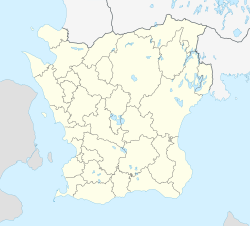Ivetofta
| Ivetofta | |
|---|---|

Ivetofta Church
|
|
| Location in Skåne County | |
| Coordinates: 56°5′11″N 14°28′35″E / 56.08639°N 14.47639°ECoordinates: 56°5′11″N 14°28′35″E / 56.08639°N 14.47639°E | |
| Country | Sweden |
| Province | Skåne |
| County | Sweden |
| Municipality | Bromölla Municipality |
| Time zone | CET (UTC+1) |
| • Summer (DST) | CEST (UTC+2) |
Ivetofta is a village and a suburb of Bromölla, in Skåne County in southern Sweden. With a history going back to the 12th century, it was once a rural municipality in the former Kristianstad County. It lies on the eastern bank of Ivö Lake, between Ivö and the smaller lake Levrasjön. The Ivetofta Local Historical Society was founded in 1981 and as of 2013 has nearly 500 members.
The village is located between Ivösjön and Hanöbukten, and consists of the forested Ryssberget hill and sandy plains which are cultivated. The habitats are characterized as pine forest, deciduous forest, meadow, pasture, and grassy heath.
The name is first documented in 1319 as Ywätoffte. It stems from the old name Ivösjön, the Ivö Lake, and "toft" meaning farm. Bromölla, of which Ivetofta is a suburb, came to be established initially as a borough when limestone was found nearby, and later became a municipality. The origin of its name is attributed to a mill named Bromölla which existed on the bank of the Skräbe River and is dated to the 1460s. A ceramic vessel discovered at Ivetofta attests to prehistoric hunter-gatherers who predated farming here. Palaeontological finds include Plesiosaurian bone fragments which were provided to the Palaeontological Institute of Lund in 1961 from a borehole, while archaeology has uncovered cremation urns from pits estimated as Late Bronze Age.
Ivetofta Church was probably built in the 12th century; the tower (built in stone and decorated with carved sandstone) on the western side was added in the 13th century. The altar, pulpit, pews and the baptismal font were donated by Sophia Brahe in the early 17th century, who had moved to the area with her second husband and was known for her work in Danish genealogy. These features have been retained in the renovated church. Brahe had planned on being buried there but returned to her native Denmark, settling in Helsingør before she died. Her planned headstone is on display at Ivetofta church.
...
Wikipedia


